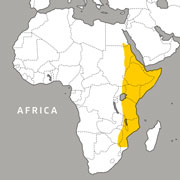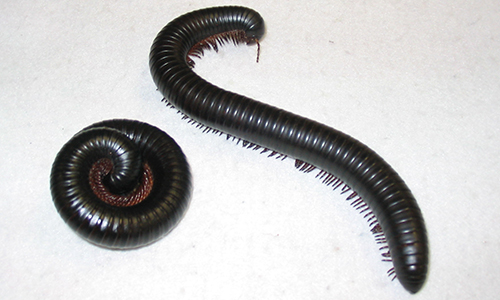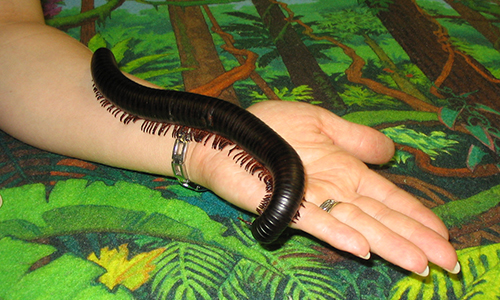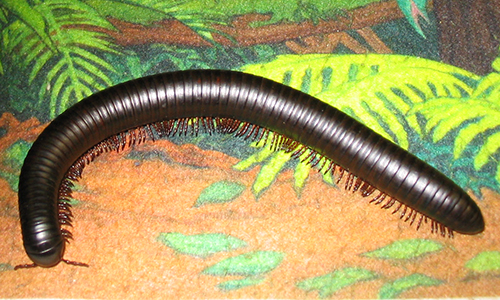Giant African Millipede
Archispirostreptus gigas
About the Giant African Millipede

Geographic Range:

Class: Invertebrate
Order: Julida
Family: Spirostreptidae
Genus: Archispirostreptus
Species: gigas
The giant african millipede is as thick as a human thumb and sheathed in a tough black cuticle. Like other millipedes and centipedes, its body is divided into many segments, each with two pairs of legs. The millipede has a pair of antennae, which it uses to navigate its environment because it does not have eyes. When threatened, the millipede will curl into a ball to protect itself or excrete a foul-tasting liquid.
Giant African Millipede Facts
Class: Invertebrate
Order: Julida
Family: Spirostreptidae
Genus: Archispirostreptus
Species: gigas
Appearance:
Millipedes’ bodies are covered with a tough black cuticle, and they’re as thick around as an adult thumb. Millipedes don’t have eyes; they use a pair of antennae to sense what’s around them. Their mandibles (jaws), used to chew on plants, resemble those of insects.
Although the name “millipede” means “1000 feet,” adults probably have only 200-300 feet. Like other millipedes and centipedes, the giant African millipede’s body is divided into many segments. Unlike centipedes, which have only one pair of legs per segment, millipedes have two per segment.
Millipedes have only three pairs of legs at birth. In order to grow, millipedes must go through a series of molts (shedding of their exoskeletons). Each time they molt, they add two pairs of legs per body segment, which gives them the appearance of having hundreds of legs. The molting process, in which a millipede spends about 10% of its life, can be dangerous. Millipedes are vulnerable to attack during this time, so they have to find a safe place to hide.
Size:
Up to 12 inches long
Life Expectancy:
Wild:Unknown
Up to seven years in captivity
Habitat/Range:
Found in rainforests throughout Africa, giant African millipedes can be found living under rocks in soil and leaves.
Reproduction:
There’s no fixed breeding season for this millipede. A few weeks after copulation, the female lays hundreds of eggs, building a nest out of soil just below ground level. Eggs hatch after three months, and neonates (newborns) molt within 12 hours. Millipedes reach maturity within three years.
Diet:
Since millipedes eat the dead plant materials lying on the ground, they’re considered “nutrient recyclers,” making them a valuable organism for the environment.The diet of Franklin Park Zoo’s millipedes includes apples and cuttlebone.
Behavior:
When threatened, millipedes excrete a foul-tasting liquid. Their main line of defense is to curl up into a ball with their softer underbelly inside the ball.
You Can Find This Animal in the Bird's World Exhibit
You May Also Like
At Franklin Park Zoo:







